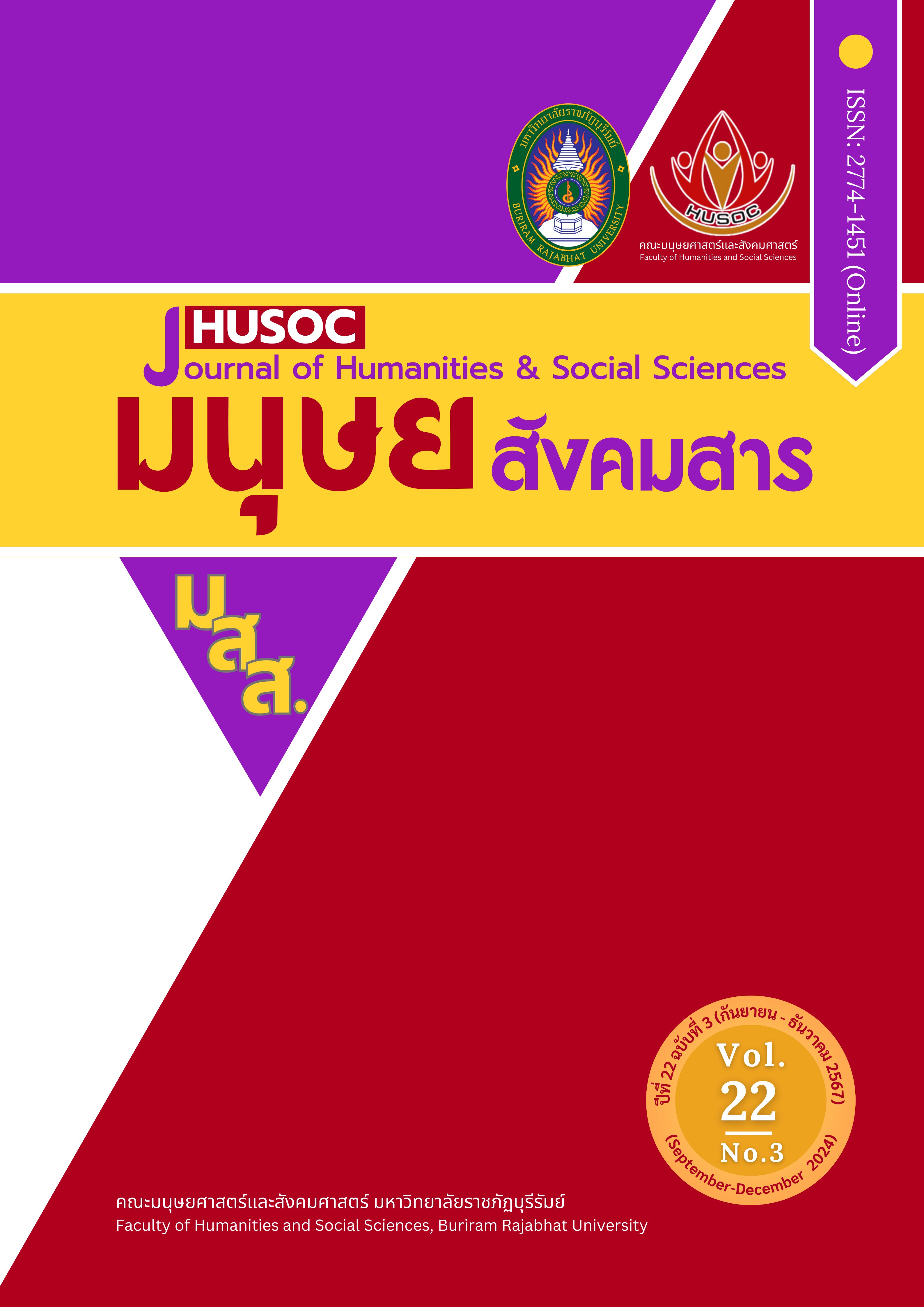การพัฒนาศักยภาพชนเผ่าไทกวน บ้านนาถ่อน สู่การท่องเที่ยวชุมชนเชิงสร้างสรรค์ เพื่อรองรับนักท่องเที่ยวมูลค่าสูง
Main Article Content
บทคัดย่อ
การวิจัยเรื่องนี้มีวัตถุประสงค์เพื่อ 1) ศึกษาศักยภาพการท่องเที่ยวชุมชนชนเผ่าไทกวน บ้านนาถ่อน 2) ศึกษาพฤติกรรมของกลุ่มนักท่องเที่ยวมูลค่าสูงที่เดินทางมาท่องเที่ยวชนเผ่าไทกวน บ้านนาถ่อน และ 3) เสนอแนะแนวทางการพัฒนาศักยภาพการท่องเที่ยวชุมชนเชิงสร้างสรรค์บ้านนาถ่อน เพื่อรองรับนักท่องเที่ยวมูลค่าสูง โดยงานวิจัยครั้งนี้ใช้วิธีการแบบผสมผสานทั้งเชิงปริมาณและเชิงคุณภาพ โดยการเก็บแบบสอบถามจากกลุ่มนักท่องเที่ยวมูลค่าสูงที่เดินทางมายังบ้านนาถ่อน จังหวัดนครพนม และการเก็บข้อมูลจากการสัมภาษณ์ผู้มีส่วนเกี่ยวข้อง ผลการวิจัยพบว่า จำนวนผู้ตอบแบบสอบถามส่วนใหญ่เป็นคนในภาคตะวันออกเฉียงเหนือ โดยมีวัตถุประสงค์ในการเดินทางท่องเที่ยวเพื่อเรียนรู้วิถีชีวิต ภูมิปัญญาท้องถิ่น และมีค่าใช้จ่ายทั้งหมดในการเดินทางท่องเที่ยว (เฉลี่ยต่อครั้งต่อคน) อยู่ในช่วง 2,000 - 5,000 บาท ทั้งนี้แนวทางการพัฒนาศักยภาพชุมชนบ้านนาถ่อน จังหวัดนครพนม เพื่อรองรับการท่องเที่ยวมูลค่าสูง มีดังนี้ 1) การมีส่วนร่วมของชุมชนในท้องถิ่น 2) การพัฒนาจิตสำนึกทางการท่องเที่ยว 3) การสร้างเส้นทางการท่องเที่ยวชุมชน และ 4) การพัฒนาผลิตภัณฑ์ท่องเที่ยวและพัฒนาผลิตภัณฑ์ที่มีคุณภาพพร้อมยกระดับตราสินค้าได้
Article Details

อนุญาตภายใต้เงื่อนไข Creative Commons Attribution-NonCommercial 4.0 International License.
เนื้อหาและข้อมูลในบทความที่ลงตีพิมพ์ในวารสารทดสอบระบบ ThaiJo2 ถือเป็นข้อคิดเห็นและความรับผิดชอบของผู้เขียนบทความโดยตรงซึ่งกองบรรณาธิการวารสาร ไม่จำเป็นต้องเห็นด้วย หรือร่วมรับผิดชอบใดๆ
บทความ ข้อมูล เนื้อหา รูปภาพ ฯลฯ ที่ได้รับการตีพิมพ์ในวารสารทดสอบระบบ ThaiJo2 ถือเป็นลิขสิทธิ์ของวารสารทดสอบระบบ ThaiJo2 หากบุคคลหรือหน่วยงานใดต้องการนำทั้งหมดหรือส่วนหนึ่งส่วนใดไปเผยแพร่ต่อหรือเพื่อกระทำการใดๆ จะต้องได้รับอนุญาตเป็นลายลักอักษรจากวารสารทดสอบระบบ ThaiJo2 ก่อนเท่านั้น
เอกสารอ้างอิง
Artharn, D., Jaroenwisan, K., & Boonmeesrisanga, M. (2022). The enhancement of safety and health protocols for sustainable homestay tourism after the COVID-19 Pandemic in Thailand. Journal of Liberal Arts, 22(1), 186-204. [in Thai]
Bamrungsin, T., Islam, R., & Kaewyu, P. (2022). A model of creative tourism development for cultural preservation of Lao Klang in Kud Jok, Chinat Province. Journal of International and Thai Tourism, 18(1), 45-61. [in Thai]
Buhalis, D. (2000). Marketing the competitive destination in the future. Tourism Management, 21(1), 97-116.
Chaiwkasem, O. (2015). Cultural tourism in Tai Lu community Tambon Ban Thin, Amphoe Mueang Phrae, Phrae. Dhonburi Rajabhat University, Office of Academic Resources and Information Technology. http://cms.dru.ac.th /jspui/handle/123456789/916
Choibamroong, T. (2019). Direction of Thai tourism development towards sustainability. National Institute of Development Administration. [in Thai]
Dickman, S. (1996). Tourism: An introductory text. Hodder Education.
Esichaikul, R. (2014). Niche tourism management. Sukhothai Thammathirat University. [in Thai]
Grey Richards & Derek Hall. (2000). Creative tourism. ATLAS News, 23, 16-20. Jittangwattana, B. (2005). Sustainable tourism development. Press and Design. [in Thai]
Mason, C. L. (1990). Concept mapping: A tool to develop reflective science instruction. Science Education, 76(1), 51-57.
Ministry of Tourism and Sport. (2023). National tourism development plan Vol 3 (2023–2027). The War Veterans Organization of Thailand Under Royal Patronage. [in Thai]
Munchoei, N., Tati, S., & Kanthane, S. (2020). User interface design and implementation for travel recommendation mobile application to stimulate tourism economics under We Love Chiang Mai Project. Journal of Management Science Pibulsongkram Rajabhat University, 2(2), 1-12. [in Thai]
Nakhon Phanom Provincial Office. (2021). Nakhon Phanom provincial development plan (2023-2027). http://www2.nakhonphanom.go.th/news/detail/596
Nua-amnat, R., Phratheppariyattimedhi, & Girdwicha, N. (2019). Developing model of creative community-based tourism management in Nakornsawan province. Mahachula Academic Journal, 7(1), 72-88. [in Thai]
Nunnally, J. C. (1978). Psychometric theory (2nd. ed.). McGraw-Hill.
Pasunon, P. (2010). Business statistics. TOP. [in Thai]
Pelasol, R. J. (2012). Igcabugao: A potential tourist destination in the southern part of Iloilo, Philippines. International JPAIR Multidisciplinary Research. Certified for QMS ISO 9001-2008 by the Anglo Japanese American Registrars of the UK.
Rocharungsat, R. (2010). Community tourism. Odeon Store. [in Thai]
Rungfamai, K., & Sritongmas, S. (2019). Sustainable success of homestay from the perspectives of homestay community leaders in four regions of Thailand. University of the Thai Chamber of Commerce Journal Humanities and Social Sciences, 39(3), 106-120. https://utcc2.utcc.ac.th/utccjournal/ 393/106_120.pdf [in Thai]
Srilachai, A. (2018). Guidelines for sustainable tourism management for community-based tourism: A case study of Ban Kokmuang, Jorakhemak, Prakhonchai District, Buriram Province. Journal of Graduate Studies Valaya Alongkron Rajabhat University, 12(1), 218-229. [in Thai]
Thammabut, P. (2006). Teaching materials on the principles of ecotourism. Institute of Ecotourism, Srinakharinwirot University. [in Thai]
Visadsoontornsaku, P., Na Thalang, C., Jittithavorn, C., & Tungbenchasiriku, S. (2020). Potentiality development approach for community-based tourism in Nakhon Ratchasima Province. The Journal of Development Administration Research, 10(3), 22-33. [in Thai]
Wiriyasumon, S. (2008). A complete research report compiling knowledge on the status and situation of community tourism in the lower northern region. Faculty of Humanities and Social Sciences, Pibulsongkram Rajabhat University. [in Thai]
Zhang, Z., Plathong, S., Sun, Y., Guo, Z., Munnoy, T., Ma, L., Jantharakhantee, C., & Tanboot, L. (2020). Analysis of the island tourism environment based on tourists' perception: A case study of Koh Lan, Thailand. Ocean & Coastal Management, 197. https://doi.org/10.1016/j.ocecoaman.2020.105326


